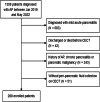Early encapsulation of peripancreatic fluid/necrosis collections on imaging (CECT) in acute pancreatitis: influential factors and clinical significance for prognosis
- PMID: 38287237
- PMCID: PMC10826178
- DOI: 10.1186/s12876-024-03145-7
Early encapsulation of peripancreatic fluid/necrosis collections on imaging (CECT) in acute pancreatitis: influential factors and clinical significance for prognosis
Abstract
Background: To identify the factors influencing the early encapsulation of peripancreatic fluid/necrosis collections via contrast-enhanced computed tomography (CECT) and to determine the clinical significance of early encapsulation for determining the prognosis of acute pancreatitis (AP) patients.
Methods: AP patients who underwent CECT between 4 and 10 days after disease onset were enrolled in this study. Early encapsulation was defined as a continuous enhancing wall around peripancreatic fluid/necrosis collections on CECT. Univariate and multivariate logistic regression analyses were performed to assess the associations between the variables and early encapsulation. Clinical outcomes were compared between the non-encapsulation and early encapsulation groups with 1:1 propensity score matching.
Results: A total of 289 AP patients were enrolled. The intra-observer and inter-observer agreement were considered good (kappa statistics of 0.729 and 0.614, respectively) for identifying early encapsulation on CECT. The ratio of encapsulation increased with time, with a ratio of 12.5% on day 5 to 48.7% on day 9. Multivariate logistic regression analysis revealed that the longer time from onset to CECT examination (OR 1.55, 95% CI 1.23-1.97), high alanine aminotransferase level (OR 0.98, 95% CI 0.97-0.99), and high APACHE II score (OR 0.89, 95% CI 0.81-0.98) were found to be independent factors associated with delayed encapsulation. The incidence of persistent organ failure was significantly lower in the early encapsulation group after matching (22.4% vs 6.1%, p = 0.043). However, there was no difference in the incidence of infected pancreatic necrosis, surgical intervention, or in-hospital mortality.
Conclusions: AP patients without early encapsulation of peripancreatic fluid/necrosis collections have a greater risk of persistent organ failure. In addition to longer time, the high APACHE II score and elevated alanine aminotransferase level are factors associated with delayed encapsulation.
Keywords: Acute pancreatitis; Contrast-enhanced computed tomography; Infection; Organ failure; Risk factors.
© 2024. The Author(s).
Conflict of interest statement
The authors declare no competing interests.
Figures



Similar articles
-
Peripancreatic collections in acute pancreatitis: correlation between computerized tomography and operative findings.World J Gastroenterol. 2010 Sep 14;16(34):4291-6. doi: 10.3748/wjg.v16.i34.4291. World J Gastroenterol. 2010. PMID: 20818812 Free PMC article.
-
Revised Atlanta classification for CT pancreatic and peripancreatic collections in the first month of acute pancreatitis: interobserver agreement.Eur Radiol. 2019 May;29(5):2302-2310. doi: 10.1007/s00330-018-5906-0. Epub 2019 Jan 10. Eur Radiol. 2019. PMID: 30631920
-
New Risk Factors for Infected Pancreatic Necrosis Secondary to Severe Acute Pancreatitis: The Role of Initial Contrast-Enhanced Computed Tomography.Dig Dis Sci. 2019 Feb;64(2):553-560. doi: 10.1007/s10620-018-5359-y. Epub 2018 Nov 22. Dig Dis Sci. 2019. PMID: 30465178
-
Management of gallstone pancreatitis.Adv Surg. 2006;40:265-84. doi: 10.1016/j.yasu.2006.06.005. Adv Surg. 2006. PMID: 17163108 Review.
-
Updated imaging nomenclature for acute pancreatitis.AJR Am J Roentgenol. 2014 Nov;203(5):W464-9. doi: 10.2214/AJR.13.12222. AJR Am J Roentgenol. 2014. PMID: 25341160 Review.
References
MeSH terms
Substances
LinkOut - more resources
Full Text Sources
Medical

